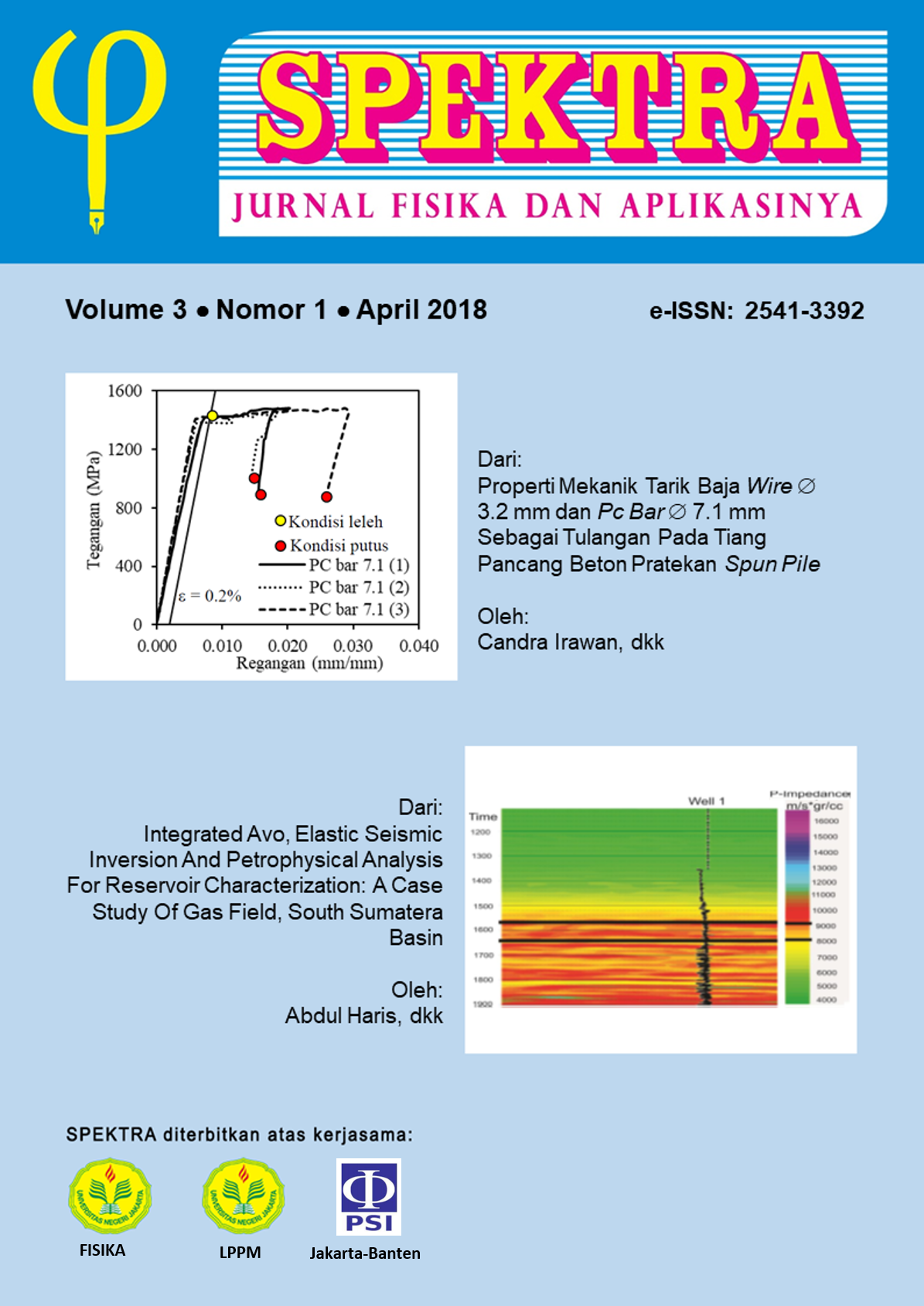ANALYSIS OF PROCIMATE ON THE CHARCOAL BRICKET AGRICULTURAL WASTE
DOI:
https://doi.org/10.21009/SPEKTRA.031.03Abstract
Abstract
Research has been conducted to know the best and worst quality of charcoal briquettes from agricultural wastes based on their proximate content. These agrarian wastes are rice husk, sugarcane baggage, cassava peel, corncob, and coconut shell. The research method is pyrolysis carbonization at 700-800 oC for 45 min and proximate analysis with techniques that suitable Indonesian National Standard (SNI) for testing of moisture, ash, volatile matter, and fixed carbon content. The research result showed that the best charcoal briquettes quality is cassava peel because it has the lowest water content of 0.3833% and the lowest ash content of 0.8452%. While the worst charcoal briquettes quality is corncob because it has the highest water content of 2,412% and the lowest fixed carbon of 71,442%.
Keywords: charcoal briquettes, agricultural wastes, proximate analysis.
References
[2] Risna. 2016. Pengaruh Tekanan Dan Ukuran Partikel Terhadap Kualitas Briket Arang Cangkang Coklat. Universitas Halu Oleo. Kendari.
[3] Setiawan. 2007. Memanfaatkan Kotoran Ternak, Solusi Masalah Lingkungan Dan Pemanfaatan Energi Alternatif. Penebar Swadaya. Depok.
[4] Sinurat, E. 2011. Studi pemanfaatan briket kulit jambu mete dan tongkol jagung sebagai bahan bakar alternatif. Universitas Hasanuddin. Makassar.
[5] Elfiano, E., Subekti, P., dan Sadil, A. 2014. Analisa Proksimat Dan Nilai Kalor Pada Briket Biomassa Limbah Ampas Tebu Dan Arang Kayu. Jurnal Aptek. Vol. 6 No. 1 pp. 58
[6] Delly, J dan Saputra, N. 2014. Proses Pembuatan Briket Berbasis Kulit Singkong Dan Kajian Eksperimen Parametris Pengaruh Bahan Perekatnya Terhadap Nilai Kalor Dan Laju Pembakaran. Jurnal Ilmiah Teknik Mesin. Vol. 6, No. 1. Hal. 4
[7] SNI 13-3477-1994 : Analisis Kadar Air Lembab dari Contoh Batubara Kering Udara.
[8] SNI 13-3478-1994 : Analisis Kadar Abu Contoh Batubara.
[9] SNI 13-3999-1995 : Analisis Kadar Zat Terbang (Volatile) Contoh Batubara.
[10] SNI 13-3479-1994 : Analisis Kadar Karbon Tertambat Contoh Batubara.
[11] Sipahutar, D. 2010. Teknologi Briket Sekam Padi. Badan Pelayanan Perizinan Terpadu. Riau.
[12] Subekti. 2006. Produksi Etanol dari Hidrolisat Fraksi Selulosa Tongkol Jagung oleh Saccharomyces Cerevisiae. Institut Pertanian Bogor. Bogor.
[13] BPS. 2015. Produksi Padi, Jagung, dan Kedelai. Berita Resmi Statistik. No. 28/03/Th. XVIII, 2 Maret 2015.
[14] Nugraha, J. R. 2013. Karakteristik Termal Briket Arang Ampas Tebu dengan Variasi Bahan Perekat Lumpur Lapindo. Skripsi. Universitas Jember. Jember.
[15] Mahmud, Z dan Ferry, Y. 2005. Prospek Pengolahan Hasil Samping Buah Kelapa. Perspektif. Vol. 4, No. 2. Hal 55-63.
[16] Moeksin, R., M. T., dan Kunchoro, A. 2015. Pengaruh Komposisi Pembuatan Biobriket dari Campuran Serbuk Gergaji, Kulit Singkong, dan Batubara terhadap Nilai Pembakaran. Jurnal Teknik Kimia. Vol. 21, No. 4. Hal 19-26.
[17] Surono, U. B. 2010. Peningkatan Kualitas Pembakaran Biomassa Limbah Tongkol Jagung sebagai Bahan Bakar Alternatif dengan Proses Karbonisasi dan Pembriketan. Jurnal Rekayasa Proses. Vol. 4, No. 1. Hal 13-18.
Downloads
Published
How to Cite
Issue
Section
License
SPEKTRA: Jurnal Fisika dan Aplikasinya allow the author(s) to hold the copyright without restrictions and allow the author(s) to retain publishing rights without restrictions. SPEKTRA: Jurnal Fisika dan Aplikasinya CC-BY or an equivalent license as the optimal license for the publication, distribution, use, and reuse of scholarly work. In developing strategy and setting priorities, SPEKTRA: Jurnal Fisika dan Aplikasinya recognize that free access is better than priced access, libre access is better than free access, and libre under CC-BY or the equivalent is better than libre under more restrictive open licenses. We should achieve what we can when we can. We should not delay achieving free in order to achieve libre, and we should not stop with free when we can achieve libre.
 SPEKTRA: Jurnal Fisika dan Aplikasinya is licensed under a Creative Commons Attribution 4.0 International License.
SPEKTRA: Jurnal Fisika dan Aplikasinya is licensed under a Creative Commons Attribution 4.0 International License.
You are free to:
Share - copy and redistribute the material in any medium or format
Adapt - remix, transform, and build upon the material for any purpose, even commercially.
The licensor cannot revoke these freedoms as long as you follow the license terms.

 E-ISSN 2541-3392
E-ISSN 2541-3392  Focus & Scope
Focus & Scope  Editorial Team
Editorial Team  Reviewer Team
Reviewer Team  Author Guidelines
Author Guidelines  Article Template
Article Template  Author Fee
Author Fee  Publication Ethics
Publication Ethics  Plagiarism Policy
Plagiarism Policy  Open Access Policy
Open Access Policy  Peer Review Process
Peer Review Process  Retraction & Correction
Retraction & Correction  Licensing & Copyright
Licensing & Copyright  Archiving & Repository
Archiving & Repository  Contact
Contact  Mendeley
Mendeley 

